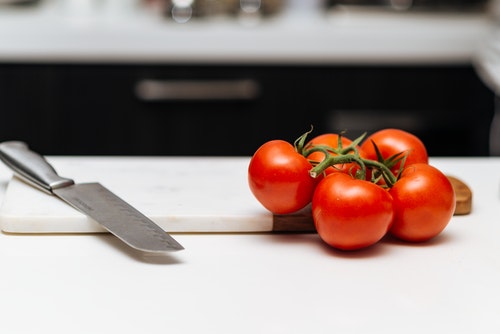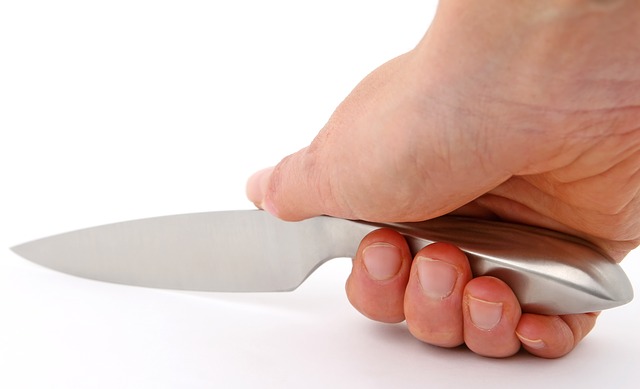A dull knife is a dangerous one. If you are chopping up meat and use a dull one, it may slip at some point, and then you could get cut. It’s just not worth taking the chances when there are so many other reasons to sharpen your knives.
One of the most important things about sharpening kitchen knives is that one angle is not best for all knives. Different blades have different designs, and depending on how you will use your blades, you may not want the same angle for each.
What Is An Angle?
An angle in sharpening kitchen knives is the degree to which you hold your kitchen knife’s blade to the sharpening stone.
The angle refers to the angle at which you sharpen your knives. The angle will determine how well the knife can cut and how sharp. If you sharpen a knife with a straight Angle, it has a shorter edge that can be sheared off easier than an acute angle one. Having the right angle will make your knife sharp enough to cleave even hard materials.
Does Angle Matter In Sharpening?
The simple answer – yes. The longer answer? It depends on what surface you’re trying to get a sharp edge on. Are you trying to get a sharp blade for use on a grinding wheel or belt sander? Are you trying to put a razor-sharp edge on the blade that can cut through carrots like water?
The angle at which you sharpen your kitchen knives does matter. There are three different angles for sharpening: single bevel, double bevel, and convex.
Why Do Knives Have Different Angles?
Knives have different angles for several reasons. Sometimes the angle is due to the type of work you want to do with the knife, and sometimes it’s a matter of preference.
Japanese knives are generally thinner and have a sharper cutting angle than Western knives, making them ideal for delicate dishes like sushi. You want to cut with precision and cleanly slice through ingredients without tearing or crushing them.
A knife that is thicker, or has a wider cutting angle, is more suitable for tough cuts of meat and hacking through bones. Sharpening uses up metal on the blade over time, so it’s important to consider how often you need to sharpen your knife before buying one.
There are two main types of knives that determines the user’s angle while sharpening:
- Asian-style knives (typically used for cutting vegetables)
- Western-style knives (used for meat).
The key difference between Asian and Western knives is how they’re shaped. Asian knives have an angled edge and meet the food at a point rather than the flat edge of the blade meeting the food along its whole length. Because of this design difference, Asian-style knives require a smaller sharpening angle than Western-style knives.
Western-style knives require a larger sharpening angle than Asian style knives because they’re typically used to slice meats that need more pressure to cut them thoroughly.

What Exactly Is The Ideal Angle For Sharpening Knives?
The angle used for sharpening a knife is determined by the type and use of the knife. The basic rule is that a knife with a thinner blade cut better with a sharper angle, while a thicker blade gets sharper with a steeper angle.
Understanding the Right Angle to Sharpen Knives:
To understand the best angle to sharpen your knife, you need to consider three things:
- The use of the knife: What you intend to do with your knife determines how and at which angle you will sharpen it.
- The type of steel used in creating the edge: The hardness and quality of steel used in making blades can affect how often they need sharpening.
Honing rods, stones, or sharpeners used on knives: Using different materials affects how many times you can sharpen a blade and how long it takes before you need to resharpen it again.
Different Types of Knife Angles
What’s great about honing tools is that their tips are generally pre-set at an optimum 20 degrees angle. But there are many other options.
Angles of under 10 degrees
This type of degree is used to cut software material through blade edges. Under 10-degree angles are perfect for sharpening straight edge razors. Its edges are soft, so proper care of a straight edge is required to avoid damage.
Angles of 10 to 17 degrees
A low sharpening edge of 10 to 17 degrees can be used on most blades. Given that sharpening at such an angle would total 20 to 34 degrees, it’s an extremely tiny angle edge. It is used where smooth cutting is required, like a slice of meat.
Angles of 17 to 22 degrees
The usual sharpening angle for most basic kitchen knives is 17 to 22 degrees. Some knives, particularly those made in Japan, were honed to the recommended 17-degree angle. On the other hand, Western-style kitchen knives like a sharpening angle of roughly 20 degrees.
Angles of 22 to 30 degrees
It is the most long-lasting knives sharpener. This type of edge could be effective for not just slicing and chopping but also grinding, sawing, and to some extent screwing. As a result, an angled edge of 22 to 30 degrees is appropriate for such blades, making them more robust.
Angles greater than 30 degrees
Any blade with a sharpening angle greater than 30 degrees has extremely durable edges. Cleavers, machetes, and axes are examples of tools and knives with such angles. Its edges will be durable, but its sharpness will be reduced. As a result, while using such tools on hard objects like chopping down trees, greater strength is necessary.
Summary:
The simple, straightforward answer is that using a standard 20-degree angle guided sharpening system, or a 20-degree angle guided pull-through sharpener will perform the best and provide consistent angles every time without fail. With this small investment for a tool that will last you a lifetime, you’ll be able to sharpen your kitchen knives fast and easy without fail, whatever your skill level.


